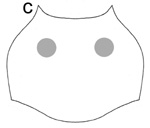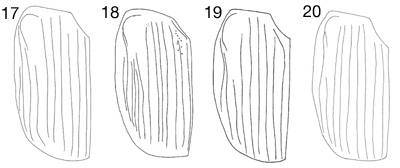| 1. . . .. |
Protarsomeres 1-4 subequal in length to protarsomere 5 (Fig. 1). Protarsomere 5 with internomedial protuberance (Fig. 1). Larger claw of protarsus with ventral ramus about 4 times wider than dorsal ramus (Fig. 1). Abdominal sternites weakly concave | |||||||
| 1'. |
Protarsomeres 1-4 longer than protarsomere 5 (Fig. 2). Protarsomere 5 lacking internomedial protuberance (Fig. 2). Larger claw of protarsus with ventral ramus 1 to 2 times wider than dorsal ramus (Fig. 2). Abdominal sternites weakly convex | |||||||
|
||||||||
| 2(1). . |
Epipleural expansion extends from base of elytron to middle of metacoxa (Fig. 3). Frons with disc convex (Fig. 5) | |||||||||||||
|
2'. |
Epipleural expansion extends from base of elytron to first or second abdominal sternite (Fig. 4). Frons disc flat to weakly concave (Fig. 6) | |||||||||||||
|
||||||||||||||
| 3(2). . . . |
Parameres setose. Frons with disc setose. Pronotum black, rugopunctate, (punctures dense). Pronotum densely setose. Pronotum and venter with reddish setae. Genitalia as in Figs. 7a-c | |||||
|
3'. |
Parameres glabrous. Frons with disc glabrous. Pronotum testaceous, with or without castaneous macula at middle, punctate (punctures moderately dense). Pronotum sparsely to moderately setose. Pronotum and venter with tawny setae. Genitalia as in Figs. 8a- c | |||||
|
||||||
| 4(2). . |
Length of clypeus in ventral view about 1/2 length of mentum (Fig. 9). Genitalia as in Figs. 11a-c |
E.
mexicana (Burmeister) |
||||||||
|
4'. |
Length of clypeus in ventral view about 1/3 to 1/4 length of mentum (Fig. 10). Genitalia not as Figs. 11a-c | |||||||||
|
||||||||||
| 5(4). . |
Pronotum with setae on entire disc or at apical angles (Fig. 12a) or at apical angles and margins (Fig. 12b) |
. 6 |
||
|
5'. |
Pronotum glabrous (with or without setae at lateral margins) or with 1-10 setae either side of disc (Fig. 12c) | |||
|
||||
|
6(5). |
Elytron with first 3 intervals punctate in basal half. Base of clypeus in lateral view with weak protuberance (Fig. 13). Elytra with opaque surface. Genitalia as in Figs. 15a-c | |||||||||||||
|
6'. |
Elytron with impunctate intervals. Base of clypeus in lateral view without protuberance (Fig. 14). Elytra with shiny surface. Genitalia as in Figs. 16a-c | |||||||||||||
|
||||||||||||||
| 7(5). . . . . |
Elytron with 10 striae (Fig. 17), last stria extends from near apical border of elytron to metacoxal area (Fig. 17). Pronotum strongly convex in lateral view (more protuberant than head in lateral view) (Fig. 21). Genitalia as in Fig. 23a-c | |||||||||||||||||||
|
7'. |
Elytron with 9 or 11-13 striae (Figs. 18-20), last stria extends from near apical border of elytron to laterad of humerus (Figs. 18-20). Pronotum weakly convex in lateral view (Fig. 22). Genitalia not as in Figs. 23a-c | |||||||||||||||||||
|
||||||||||||||||||||
| 8(7). . . |
Parameres with notch in apical 1/3 (Figs. 24b-c). Elytron with 11-13 striae (Fig. 18). Genitalia as in Fig 32a-c | |||||||||||||||||||||||||||||||
|
8'. |
Parameres without notch in apical 1/3 (Figs. 25a-c, 26a-c). Elytron with 9 striae (Figs. 19-20). Genitalia not as in Fig 24a-c | |||||||||||||||||||||||||||||||
|
||||||||||||||||||||||||||||||||
| 9(8). . |
Genitalia as in Fig. 29a-c. Pronotum with about 10 whitish setae at anterior sides of disc | |||||
|
9'. |
Genitalia as in Figs. 30a-c. Pronotum with or without 1-8 tawny setae at anterior sides of disc |
E.
guatemalensis Ohaus |
||||
|
||||||
| 10(1). . |
Epipleural expansion extends from base of elytron to middle of metacoxa (Fig. 3) | |||||||
|
10'. |
Epipleural expansion extends from base of elytron to first or second abdominal sternite (Fig. 4) |
. 12 |
||||||
|
||||||||
| 11(10). . . |
Pronotum black, rugopunctate, punctures dense, densely setose. Pronotum and venter with reddish setae. Metafemur black | |
|
11'. |
Pronotum testaceous, with or without castaneous macula at middle, punctate, punctures moderately dense, sparsely to moderately setose. Pronotum and venter with tawny setae. Metafemur testaceous | |
| 12(10). |
Pronotal disc entirely setose | |
|
12'. |
Pronotal disc glabrous (with or without lateral margins setose) or with 1-10 setae at anterior sides of disc (Fig. 12c) or with sparse setae | |

Figure 12c. Position of setae on pronotum in circular area at anterior sides of disc. |
||
| 13(12). . . . |
Elytron with first 3 intervals punctate in basal half. Pronotum black, with or without brown macula, opaque. Elytron with opaque surface. Terminal abdominal sternite quadrate or rounded at apex (Fig. 27) | |||||||
|
13'. |
Elytron with impunctate intervals. Pronotum dark brown with greenish reflections, with or without testaceous base. Elytron with shiny surface. Terminal abdominal sternite sinuate at apex (Fig. 28) | |||||||
|
||||||||
| 14(12). . |
Lateral margin of elytron narrow in dorsal view (Fig. 29). Elytron with 12 striae, striae 9 and 10 closely paired |
E.
mexicana
(Burmeister) |
||||||
|
14'. |
Lateral margin of elytron broad at middle in dorsal view (Fig. 30). Elytron with 9-11 or 13 striae |
. 15 |
||||||
|
||||||||
| 15(14). . . |
Terminal abdominal sternite sinuate at apex (Fig. 28). Pronotum yellowish brown with dark brown macula at middle |
. E. pictipennis Bates |
||||||
|
15'. |
Terminal abdominal sternite quadrate or rounded at apex (Fig. 27). Pronotum reddish brown (with or without dark brown macula), dark brown, or shiny black | |||||||
|
||||||||
| 16(15). . . |
Elytron with last 2 striae closely paired (last striae extends from metacoxal area to near apical border of elytron) (Fig. 17) | |||
|
16'. |
Elytron with last 2 striae not paired (Figs. 18-20) | |||
|
||||
| 17(16). . . . . |
Apex of metatibia with last 3 external spinules with their apices weakly curved (Fig. 31). Apex of metafemur with internal area weakly projected (Fig. 33). Elytral striae arranged as in Fig. 19. Pronotum with about 10 setae at anterior sides of disc (Fig. 12c) | ||||||||||||||||
|
17'. |
Apex of metatibia with external spinules with their apices straight (Fig. 32). Apex of metafemur with internal area projected (Fig. 34). Elytral striae arranged as in Fig. 20. Pronotum with or without 1-8 tawny setae at anterior sides of disc (Fig. 12c) | ||||||||||||||||
|
|||||||||||||||||
Blanchard (Coleoptera: Scarabaeidae: Rutelinae) and description of a new genus
of Anomalini from Mexico. Coleopterists Society Monographs 2:1-60.
































